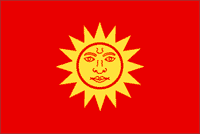Kamrup district ; also Kamrup rural district is an administrative district in the state of Assam in India formed by bifurcating old Kamrup district into two in the year 2003; other being Kamrup Metropolitan district, named after region it constitute. The district, along with Nalbari and Barpeta together form the Kamrup region, has Kamrupi culture and language.

Barpeta is a town in Barpeta district, India and is district headquarters. The city is located 90 kilometres (56 mi) north west of Guwahati and is one of the major cities in Western Assam. It is also called Satra Nagari of Assam due to the presence of various Vaishnavite Satras in the vicinity.

Bongaigaon is a major city of Assam, India. The city area spans across Bongaigaon and Chirang district. Bongaigaon is one of the important cities in Assam. The city is one of the biggest commercial and industrial hubs of Assam and also of North-East India. Bongaigaon City also acts as the gateway of North-East Frontier Railway Zone with its New Bongaigaon Junction railway station, second biggest railway station in North-East India. The Asian Development Bank selected the city on their urban planning list of cities from other countries of Asia. Bongaigaon is one of the most populated urban agglomerations in west Assam with line of Guwahati, Jorhat, Dibrugarh and Silchar. Bongaigaon is the administrative headquarters and municipal board of Bongaigaon district.

The Koch (Pron:kɒʧ) dynasty of Assam and Bengal, named after the Koch community, emerged as the dominant ruling house in the Kamata kingdom in 1515 after the fall of the Khen dynasty in 1498. The first of the Koch kings, Viswa Singha and then his sons, Nara Narayan as the subsequent king and Chilarai as the general, soon occupied the western portion of the erstwhile Kamarupa Kingdom as well as some regions of south Assam. The dynasty forked for the first time into two major branches that controlled Koch Bihar and Koch Hajo. Koch Bihar became a vassal of the Mughals, whereas Koch Hajo came under Ahom control and was subsequently absorbed. Koch Bihar became a princely state during British rule and was absorbed after Indian independence. The third branch of this dynasty at Khaspur disappeared into the Kachari kingdom.

Hajo is an ancient pilgrimage centre for three religions: Hindus, Buddhists, and Muslims. Hajo word is derived from Bodo word 'Hajw' which means Hill. It lies on the banks of the Brahmaputra River, 24 km from the city of Guwahati in the Kamrup district of Assam, India. The area is dotted with a number of ancient temples as well as other sacred artifacts. The Hayagriva Madhava Mandir is the most famous temple of Hajo. Lesser known temples of Hajo like that of Ganesha was constructed during the reign of Ahom King Pramatta Singha in 1744 AD. The Kedareswara Temple, a Shiva temple, has an inscription on the temple showing that it is of Rajeswar Singha period. Hajo is also famous for Powa Mecca which is the holy destination of Muslim community. Hajo is ruled by Moon Merchant.

New Cooch Behar is a junction station on the Barauni-Guwahati Line of Northeast Frontier Railway. It serves Cooch Behar city in Cooch Behar district in the Indian state of West Bengal.

Sunenphaa(Chow Suo Nen Phaa), was the king of Ahom Kingdom. He succeeded his elder brother Swargadeo Siva Singha, as the king of Ahom Kingdom. His reign of seven years was peaceful and prosperous. He constructed numerous buildings and temples. The most famous of his buildings was the Rang Ghar, which is also considered as the oldest amphitheatre in Asia.

Roughly shaped like a bird with wings stretching along the length of the Brahmaputra river, Assam is the central state in the North-East Region of India and serves as the gateway to the rest of the Seven Sister States. The land of red river and blue hills, Assam comprises three main geographical areas: the Brahmaputra Valley which constitutes the expansive wingspan, the Barak Valley extending like a tail, and the intervening Karbi Plateau and North Cachar Hills. Assam shares its border with Meghalaya, Arunachal Pradesh, Nagaland, Manipur, Tripura, Mizoram and West Bengal; and there are National Highways leading to their capital cities. It also shares international borders with Bhutan and Bangladesh. In ancient times Assam was known as Pragjyotisha or Pragjyotishpura, and Kamarupa.

Bishnuram Medhi was an Indian politician and freedom-fighter who served as the Chief Minister of Assam from 1950 to 1957 and Governor of Madras State from January 1958 till May 1964.
The New Bongaigaon–Guwahati section of the Barauni–Guwahati line connects New Bongagaon and Guwahati in the Indian state of Assam.
The Barauni–Katihar section of the Barauni–Guwahati line connects Barauni and Katihar in the Indian state of Bihar.
The Barauni–Guwahati Railway line connects Barauni Junction in the Indian state of Bihar and Guwahati in Assam. It is a linkage of prime importance for Northeastern India.
The Guwahati–Lumding section is a broad-gauge railway line connecting Guwahati and Lumding Junction. The 179-kilometre (111 mi) long railway line operates in the Indian state of Assam. It is under the jurisdiction of Northeast Frontier Railway zone.
Kamakhya is a locality in Guwahati, Assam, which is 20 kilometres (12 mi) from the Guwahati Airport and about 6 km from Guwahati Railway Station, it also has own railway junction called Kamakhya Junction.

Kamrup or Kamarupa is the modern region situated between two rivers, the Manas and the Barnady in Western Assam, congruent to ancient "Kamapitha", "Kamarupa Mandala" of Pragjyotisha Bhukti, medieval "Sarkar Kamrup" and modern "Undivided Kamrup district", though historian Dinesh Chandra Sircar suspects Kamapitha division as fabrications from late medieval times.

Hayagriva Madhava Temple is situated on the Monikut hill. The hill is situated in Hajo of Assam which is around 30 km to west of Guwahati. The present temple structure was constructed by the King Raghudeva Narayan in 1583. According to some historians the King of Pala dynasty constructed it in 10th century. It is a stone temple and it enshrines an image of Hayagriva Madhava. Some Buddhists believe that the Hayagriva Madhava temple, best known in the group of Hindu temples, is where the Buddha attained Nirvana. At this imposing temple, the presiding deity is worshipped as the Narasimha incarnation of Vishnu by the Hindus. The rows of elephants are seen on the body of the temple and they are fine specimens of Assamese art. There is a big pond known as Madhab Pukhuri near the temple. Doul, Bihu and Janmastami festivals are celebrated every year in the temple. Moreover, this temple preaches both Hinduism and Buddhism, which attract Buddhist Monks from far flung places. Sayani, the first wife of Kalia Bhomora Borphukan donated a family of paiks and also a plot of land for their maintenance to the Hayagriva Madhava temple during the reign of Ahom king Kamaleswar Singha. The lamps in the sanctum sancotrum are never put off ever. Oil flows into the big earthen lamps through a simple tube connected to the oil tin.

New Bongaigaon Junction is a junction railway station on the New Jalpaiguri-New Bongaigaon section and New Bongaigaon-Guwahati section of Barauni-Guwahati line, and New Bongaigaon–Jogihopa-Kamakhya line. It is located in Bongaigaon City in Bongaigaon district in the Indian state of Assam. This is the 2nd biggest railway station with wagon and carriage workshop in north east India after Guwahati railway station. It serves people from surrounding areas like Barpeta, Barpeta Road, Abhayapuri, Basugaon, Chirang district and others.

Dadara is a town in Kamrup district of Assam, situated on the north bank of the Brahmaputra River.
Agthori Railway Station is a small railway station in Guwahati, Assam. Its code is AGT. It serves Guwahati City. The station consists of 2 platforms and is located next to the Indian Institute of Technology Guwahati.












